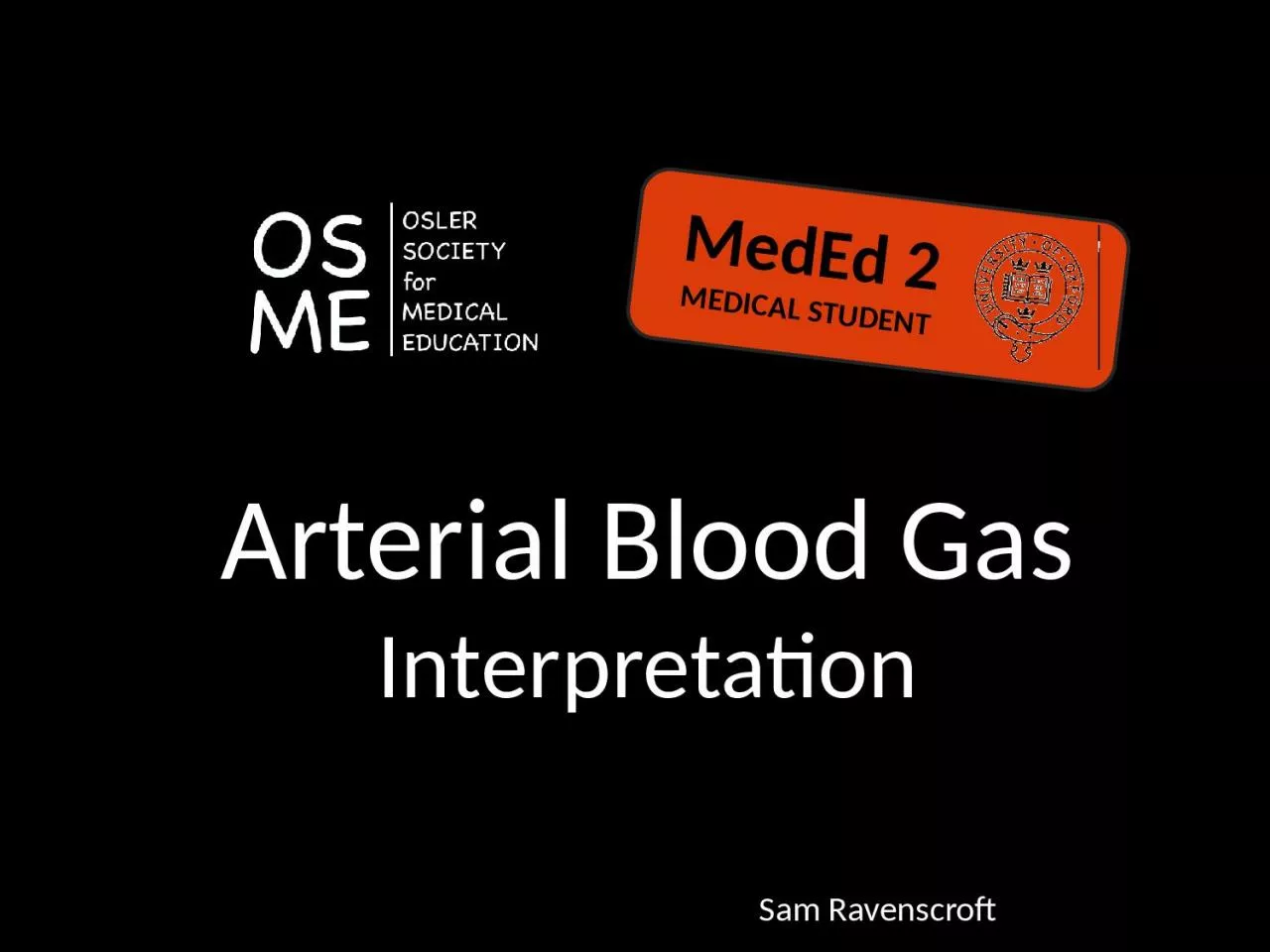

Sam Ravenscroft MedEd 2 MEDICAL STUDENT What does an ABG tell us Provides a rapid assessment of the patients respiratory and biochemical physiology ID: 999474
Download Presentation The PPT/PDF document "Arterial Blood Gas Interpretation" is the property of its rightful owner. Permission is granted to download and print the materials on this web site for personal, non-commercial use only, and to display it on your personal computer provided you do not modify the materials and that you retain all copyright notices contained in the materials. By downloading content from our website, you accept the terms of this agreement.
1. Arterial Blood GasInterpretation Sam RavenscroftMedEd 2MEDICAL STUDENT
2. What does an ABG tell us?Provides a rapid assessment of thepatient’s respiratory and biochemicalphysiologyUseful information from blood gas:Respiratory Physiology Acid Base BalanceElectrolytesExtrasGlucoseLactate
3. My system for interpreting the ABG1. Clinical context2. Respiratory failure?3. Outline abnormal values4. Acidosis or Alkalosis?5. Respiratory or Metabolic?5ii (if metabolic acidosis) Anion Gap6. Compensated or uncompensated?7. Why?
4. Clinical picture can point you in the right direction before you even start: History of anxiety ---> resp. alkalosis History of diabetes ---> DKA?It can also alert you to “false normals”: Normal PaCO2 in asthma attack Normal PaO2 on high flow oxygen1. Clinical context
5. 2. Respiratory failure?On room air, PaO2 should be > 10kPaPaO2 < 10kPa is hypoxicPaO2 < 8kPa is respiratory failureType 1 respiratory failure: PaO2 < 8kPa Type 2 respiratory failure: PaO2 < 8kPa and PaCO2 > 6kPa
6. 3. Outline abnormal valuesThis step is fairly self-explanatory....
7. 4. Acidosis or Alkalosis?Use the pH to decide thisPaCO2 skewed in the opposite direction to pH means the disturbance is respiratoryPaCO2 skewed in the same direction as pHOR an abnormal pH with a normal PaCO2 means the disturbance is metabolic5. Respiratory or Metabolic?ROME Respiratory Opposite Metabolic Equal
8. 5. Respiratory or Metabolic?pHPaCO2Metabolic acidosisMetabolic AlkalosisRespiratory AlkalosisRespiratory Acidosis
9. 6. For respiratory disturbance:Metabolic compensation can occur by altering the bicarbonate (normal 22-28)For metabolic disturbance:Respiratory compensation can occur by regulating PaCO26. Compensated or uncompensated?
10. Example 160 year old woman on the orthopaedic ward, recent hip replacement, has become short of breathpH: 7.48pO2: 8.0 kPapCO2: 3.2HCO3-: 24 mmol/l1. Clinical context2. Respiratory failure?3. Outline abnormal values4. Acidosis or Alkalosis?5. Respiratory or Metabolic?6. Compensated or uncompensated?There is alkalaemiapH and pCO2 are changed in different directions -> respiratory alkalosis
11. 1. Clinical context2. Respiratory failure?3. Outline abnormal values4. Acidosis or Alkalosis?5. Respiratory or Metabolic?6. Compensated or uncompensated?Example 2pO2: 11.5pCO2: 3.0 kPAHCO3-: 18 mmol/lGlucose : 30 mmol/l20 year old man in A&E, feeling very unwell, thirsty and drinking lots of fluidsNa+: 148 mmol/lK+: 3.5 mmol/lCl-: 100 mmol/lpH: 7.32
12. 5a. Anion Gap(Na+ + K+) - (Cl- + HCO3-)Should be 15-20Causes of a raised anion gap: Excess anions! Ketoacidosis (ETOH, diabetes, starvation) Uraemia Salicylates Methanol Aldehydes Lactic acidosis Ethylene glycol (Antifreeze)
13. Example 2pO2: 11.5pCO2: 3.0 kPAHCO3-: 18 mmol/lGlucose : 30 mmol/l20 year old man in A&E, feeling very unwell, thirsty and drinking lots of fluidsNa+: 148 mmol/lK+: 3.5 mmol/lCl-: 100 mmol/lpH: 7.32There is acidaemiaThe pH and the pCO2 are both low -> metabolic acidosisAG = 148 - 100 - 18 = 30KUSMALE
14. More examples!Split up into smaller groups togo through these with a tutor
15. Example 344 year old man in A&E (BG: Ulcerative Colitis) severe diarrhoea for 2 daysCreatinine: 200 umol/lUrea: 17Na+: 135 mmol/lK+: 3.1 mmol/lCl-: 113 mmol/lpH: 7.31pO2: 12.5pCO2: 4.0 kPAHCO3-: 14 mmol/l
16. 78 year old man hx of severe COPD, pH: 7.34pO2: 9.0 kPApCO2: 7.9HCO3-: 32 mmol/lExample 4
17. Example 5.120 year old woman with severe asthma in A&E, very short of breath, speaking in single words, on 15l O2pH: 7.47pO2: 11.2 kPApCO2: 3.7 kPAHCO3-: 25 mmol/l
18. Example 5.220 year old woman with severe asthma in A&E, She is treated with back to back nebulisers, IV magnesium and IV aminophylline, but 30 minutes later she is not improvedpH: 7.32pO2: 8.8 kPApCO2: 6.2 kPAHCO3-: 25 mmol/l
19. Example 630 year old man in A&E (BG: T1DM) has abdominal pain and vomitingNa+: 134 mmol/lK+: 5.8 mmol/lCl-: 96 mmol/lpH: 7.32pO2: 12.1 kPApCO2: 3.2 kPAHCO3-: 18 mmol/l
20. Example 766 year old man admitted with AKI ? causeAlbumin: 38 g/l (n=40 g/l)Na+: 135 mmol/lK+: 5 mmol/lCl-: 102 mmol/lUrea: 8.2 mmol/lCreatinine 115 umol/lpH: 7.28pCO2: 4.7 kPAHCO3-: 16 mmol/lLactate: 5.7